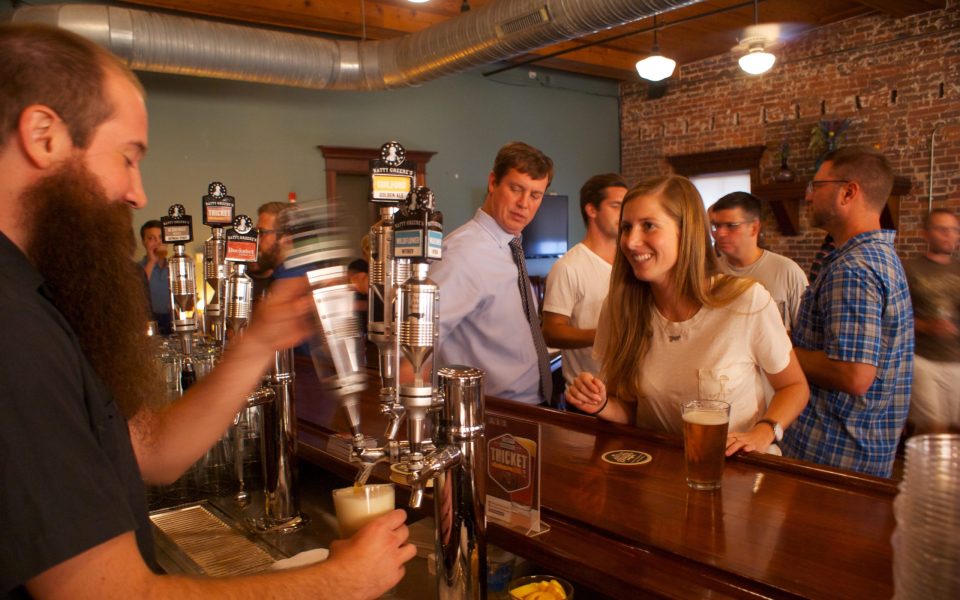by Eric Ginsburg
For the lettered members of Greensboro’s beer scene, a panel with the city’s head brewers hosted by SynerG last week held two revelations: Natty Greene’s plans to discontinue its year-round Guilford Golden beer in favor of an IPA come Jan. 1, and Preyer is about to finish a test batch of a beer it’s making in partnership with Crafted.
The neighborly collaboration, a Thai-basil lemon-ginger gose, sounds fantastic. Maybe it will taste like a cross between two recent, satisfying beers — the Basil Farmhouse Ale from Fullsteam Brewery in Durham and the Ginger-Lemon Radler from Boulevard Brewing in Kansas City.
But the Aug. 25 panel, followed by a tasting from Greensboro’s breweries, wasn’t necessarily aimed at the scene’s self-styled aficionados, though several of them turned out to the sold-out event in Natty Greene’s beautiful — and generally off-limits — third-floor space. Instead, the event provided an opportunity for the city’s four breweries to explain the past, present and future of their operations, with an eye towards economic impact.
Here’s some quick math, for those who missed it:
Pig Pounder has the smallest brewing capacity at 1,000 barrels annually, followed closely by Preyer — the city’s infant brewery — at 1,500. Gibb’s Hundred, at 2,500 barrels a year and eight employees, is still a far cry from Natty Greene’s, which can churn out more barrels at its downtown brewpub than any of its compatriots. The company has hit capacity with 20,000 barrels a year at its facility across from the Greensboro Coliseum (that doesn’t include 2,900 barrels downtown) and employs almost 100 people in the city.
 Attendees sipped pints from the host brewery as they listened to the panel discuss changing state regulations, provide examples of unnecessary red tape and attempt to distill their business philosophies. A lack of vocal projection and somewhat drab presentations dragged the panel down at first, but a question about what excites the brewers for the future brightened the event.
Attendees sipped pints from the host brewery as they listened to the panel discuss changing state regulations, provide examples of unnecessary red tape and attempt to distill their business philosophies. A lack of vocal projection and somewhat drab presentations dragged the panel down at first, but a question about what excites the brewers for the future brightened the event.
Sam Rose, the head brewer for Pig Pounder, said it’s exciting to be working somewhere with “a really eager community that hasn’t had a lot of experience yet,” because people are enthusiastic and willing to experiment. That led to an audience question about how the brewers would change the local consumer base if they could, bringing on some of the most interesting observations of the event.
Scott Christoffel, of Natty Greene’s, said that while he wouldn’t necessarily change or condition the market, he is looking forward to wider acceptance of sour beers. The brewery recently put out an easy-drinking rye saison as well as a more expensive (at $15 a bottle) Clingstone Perzik Lambic sour peach beer released on Aug. 28.
Rose talked about how Pig Pounder has struggled with people judging its dark mild based on the color and dismissing it without tasting how much it varies from a standard stout or porter of a similar shade. In general customers have expressed a feeling that the brewery’s beers are similar in color, a concern Rose said he wonders if winemakers ever have to deal with.
Mark Gibb, who co-founded Gibb’s Hundred Brewing with his wife Sasha, later drew a comparison to the wine industry as well, pointing out that nobody is asking when the wine bubble will burst despite 7,000 wineries in the country. The points about differing perceptions of beer and wine received laughs from the audience, who seemed all too aware of the contradictions.
Additional breweries would just help those that exist, Calder Preyer and other panelists agreed, as more people converted to microbrewed beer and the range of options deepened. And if the sold-out event and the energy in the room for the tastings that followed are any indication, Greensboro is far away from any sort of brewery bubble of its own.
Join the First Amendment Society, a membership that goes directly to funding TCB‘s newsroom.
We believe that reporting can save the world.
The TCB First Amendment Society recognizes the vital role of a free, unfettered press with a bundling of local experiences designed to build community, and unique engagements with our newsroom that will help you understand, and shape, local journalism’s critical role in uplifting the people in our cities.
All revenue goes directly into the newsroom as reporters’ salaries and freelance commissions.


Leave a Reply